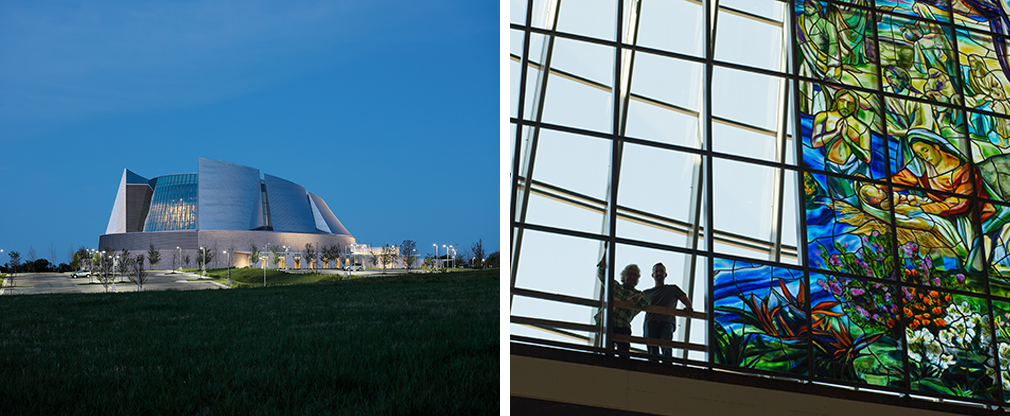
April 14, 2021
Design+ at Sundance, Slamdance, and the NYFF
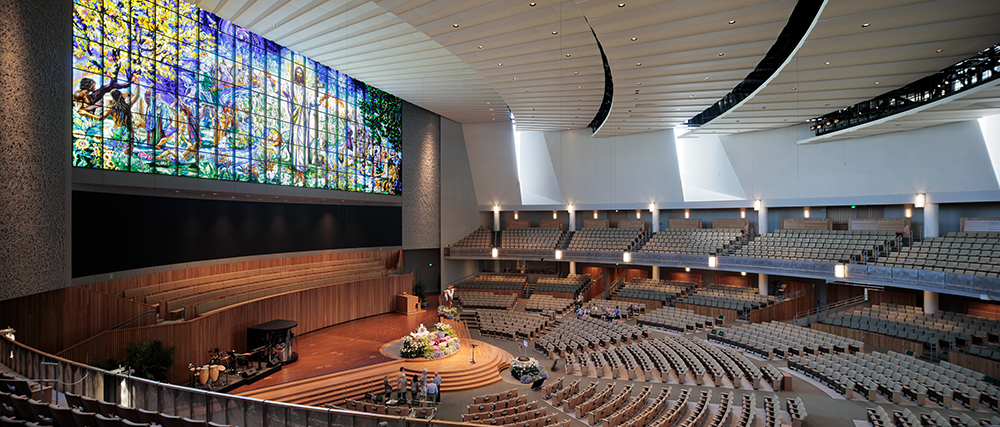
Scene from Holy Frit © Aaron Dougherty
One of the conveniences of the pandemic has been the ability to watch film festivals from the comfort of home — no waiting in queues, no schlepping in the snow, no talking in the audience. Rounding up the fruits of recent festivals including Sundance, Slamdance, and the New York Film Festival yields films that use architecture, design, and the built environment as integral to the story; employ these elements to shine a light on class, race, and inequality; address the pandemic, disasters, or other unnerving situations expressed in physical space; and scene setters which are deeply reflective of their locations. Happy streaming.
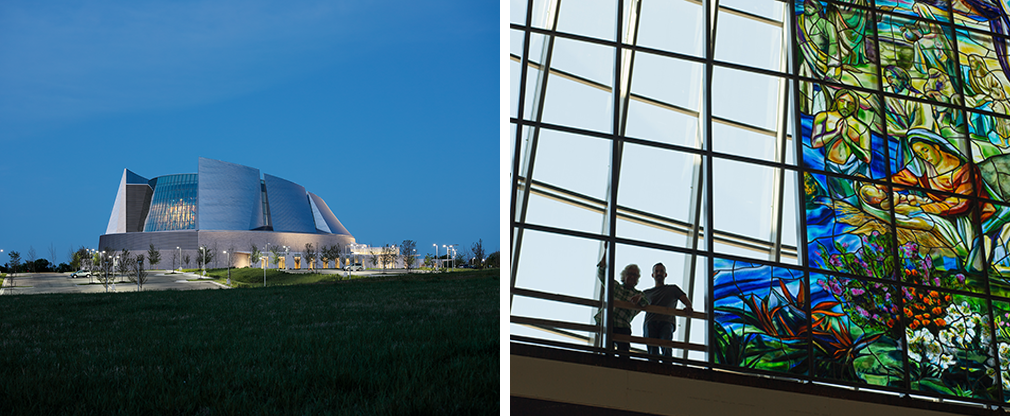
LEFT: © Aaron Dougherty RIGHT: © Judson Studios/Kyle J. Mickelson
Design and Architecture Focus
Holy Frit (Slamdance) chronicles the creation of the largest stained glass window ever made — 4,000 square feet, the size of a basketball court — for the new mega United Methodist Church of the Resurrection in suburban Kansas City, Kansas designed by HGA with Gould Evans. (Chartres’ window is 1224 sf, while Notre Dame is 1405 sf.) Pastor Adam Hamilton asks, “Does God care about art?”
Tim Carey, staff artist at LA-based Judson Studios, stained glassmakers since 1897, created the winning design. The Resurrection Window tells the biblical story with themes of creation, sin, and redemption set in three gardens and featuring nearly 40 figures in 161 5’X4’ panels. The problem is that Carey designed painterly, subtly modulated forms in a rainbow of flowing colors, whereas stained glass traditionally uses blocks of solid color, sometimes shaded, separated by heavy lead cames. Since each color is a mineral oxide (like iron, cobalt, cadmium) that heats and cools at different temperatures, if they coalesce they will crack apart. To render Carey’s composition demanded a different technology — “fusible glass,” a new invention pioneered by maestro Narcissus Quagliata that uses sprinkled frit, or granulated glass, that permits more like 50 disparate colors to cool together at the same time. The team embarks on this untested venture with steep deadlines tied to severe financial penalties. Narcissus says “the difference between painting and working with glass is …everything we do…goes through a volcano.”
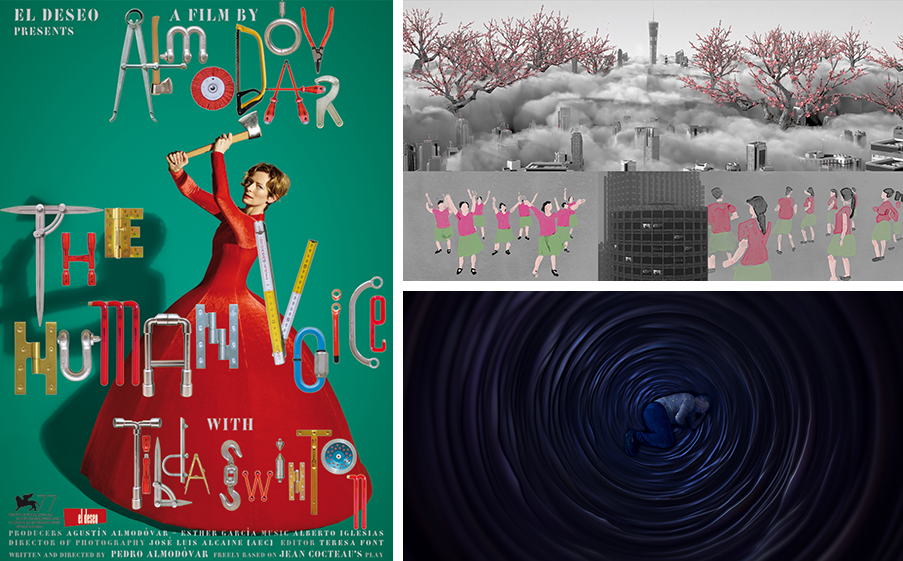
LEFT: Poster for Human Voice. TOP RIGHT: Still from Return to the Peach Blossom Wonderland. BOTTOM RIGHT: Still from Vision of Wonder.
From the arresting opening titles featuring letters rendered in shape-shifting hardware, the atmosphere of Pedro Almodovar’s The Human Voice (NYFF) is established. The solo performance by Tilda Swinton takes place in a luxurious apartment that is actually a stage set. We are shown the flats, (wooden structures that form the set’s walls), in what the filmmaker calls “the material reality of what is fictional.” In an overhead shot, Swinton is shown enclosed in a filmic doll’s house in “all the favorite colors of my palette, preference for saturation and vibrant colors, my nostalgia for Technicolor.” In the finale, the set is burned to the ground.
“The space we are surrounded by creates a constant dialogue with our own identity,” says director Tereza Vejvodová. Delimitation features a woman hunting for an apartment, from cold, steely, “soulless” flats to a high-ceilinged, colored walled apartment with scalloped ceiling mounts. Her approach to testing out where to live is to dance her way through. “What fascinates me is the space itself and our ability to discover ourselves through it, in particular that exact place we can call our home.”
Opera (Slamdance), an 8K animated installation, is defined by filmmaker Erick Oh as the contemporary edition of murals like Michelangelo’s Sistine Chapel or Hieronymus Bosch’s paintings. It is a depiction of human history progressing up and down various levels of a triangular structure in one continuous shot.
Another animation, Return to the Peach Blossom Wonderland (Slamdance), depicts a fabled utopia that, in a sense of irony, resembles modern Chinese cityscapes, and sports a tripartite composition with the center section a continuous pan down high-rise building facades. Vision of Wonder (Slamdance) depicts a carpenter, played by an actual carpenter working on actual building sites, who suffers from Charles Bonnet syndrome, a condition in which damage to the optical nerve causes the visually impaired to experience lucid hallucinations like abstract patterns. Object Lessons, Or What Happened Whitsunday (NYFF) is a fictional story told as fact: a Modernist house in upstate New York, which we see in blueprints, plans and elevations, was planned for an art collector by the fictional German architect Robert Andauer, but was never built because of a ‘murder’ on the property.
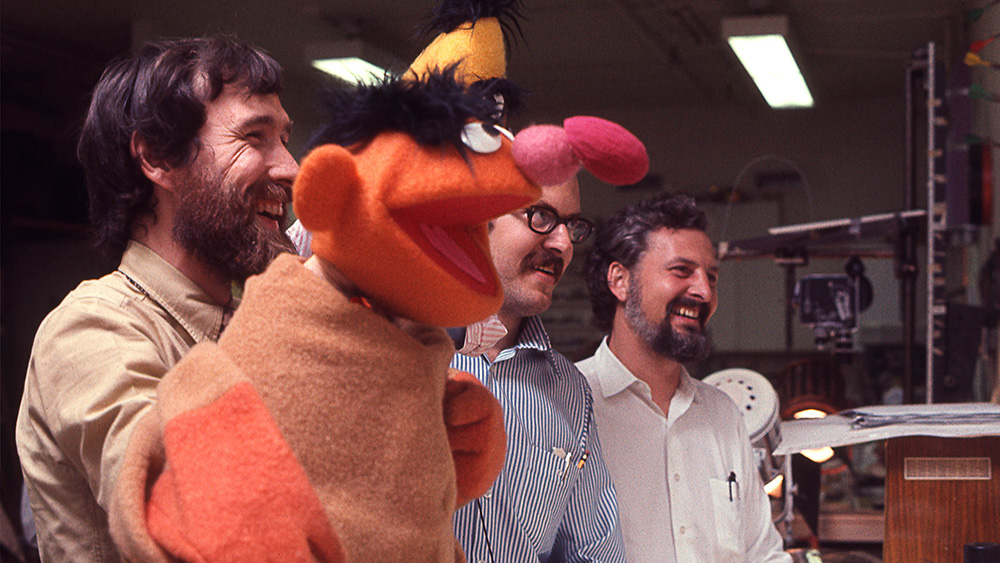
Scene from Street Gang: How We Got to Sesame Street
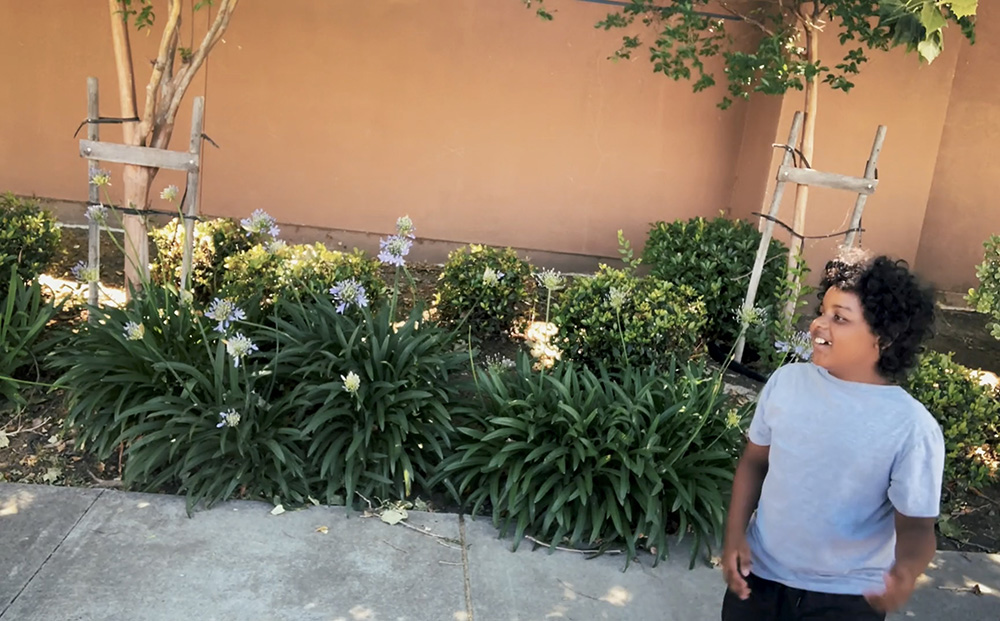
Scene from About a Home
Class, Race and Inequality
Street Gang: How We Got to Sesame Street (Sundance) was originally targeted for inner city minority youth, so was set on an urban thoroughfare with gritty elements: storefronts, garbage cans, and interracial (and interspecies) residents, all inspired by original director Jon Stone watching an NY Urban Coalition TV commercial shot on the streets of Harlem. A family documents their placement in public housing to raise awareness of homelessness around Silicon Valley in About a Home (Slamdance). Taming the Garden (Sundance) is an environmental tale of the mass uprooting of ancient, large-scale trees as tall as 15-story buildings from poor rural communities much to the consternation of villagers, trucked and then floated across he Black Sea to the privately owned beachfront estate of the richest man and former prime minister of the former Soviet republic Georgia. A fashion student leaves London for her hometown of Gijón, Spain, where she and her frayed but elegant mother live on the verge of eviction in El Planeta (Sundance) where they gently scheme to stay afloat in the post-2009 economic fallout among mid-rise apartment blocks and empty storefronts. Lata (Sundance), a 23-year old domestic, lives in her employer’s upper-class high-rise apartment in Mumbai where she undergoes a series of indignities — not counted in voter registration as a resident, cut in an elevator queue by apartment dwellers, serving her slovenly bosses — while carefully tending the elegant premises.
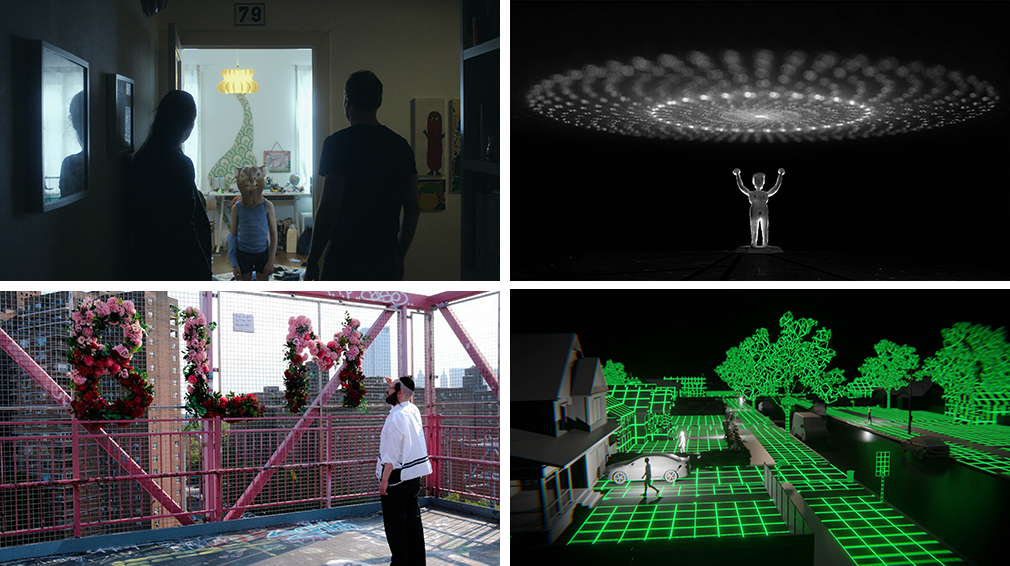
CLOCK WISE FROM TOP LEFT: Human Factors, Kkum, A Glitch in the Matrix, The Isolated.
Pandemic and Unnerving Circumstances
A deadly apparition if inhaled appears in the form of The Pink Cloud (Sundance) forcing a one-night stand into a shelter-in-place long-term relationship, as we glimpse the cityscape through their upper floor window throughout the day and night. A Chinese student returning home from studying in the U.S. films his 14-day mandatory quarantine in a bleak hotel room in Inside and Outside the Wall (Slamdance), where imaginary animals appear to him — and us. NY’s East Village during COVID is the setting for The Isolated (NYFF), with empty city streets and a soundtrack of pleading voice mails. A mother’s dreams are premonitions of the filmmaker’s life in a world of Styrofoam skyscrapers in Kkum (Sundance). Molly, who recently moved into a high-rise with desolate green hallways where she hears nightly noises from above in Knocking (Sundance), is dismissed by her neighbors and landlord as unstable while she incessantly searches the building for its source. Simulation theory believers explain themselves in A Glitch in the Matrix (Sundance), from followers of The Matrix to Elon Musk’s Twitter feed to Plato’s Republic, with VR simulation as a model. Human Factors (Sundance) starts with a Steadicam roving through an inviting holiday house in seaside Belgium before the owners arrive for the weekend where they are unsettled by an intruder, while back home in in Hamburg, Germany in their modern apartment and a skylit top floor advertising agency with distinctive trapezoidal chandelier, they live on edge between two different worlds.
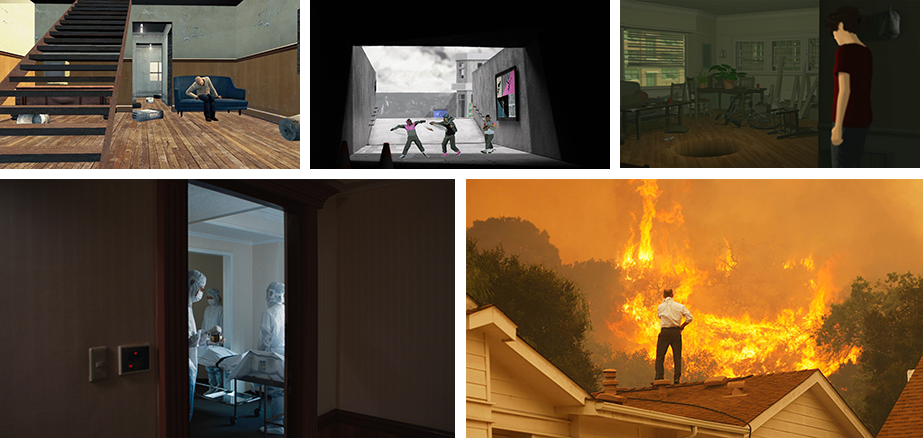
CLOCK WISE FROM TOP LEFT: The Long Fall, The Fire Next Time, Trepanation, Bring Your Own Brigade, Taipie Suicide Story.
Disasters
Inspired by the 2011 London riots, The Fire Next Time (Sundance) (the title refers to the 1963 book by James Baldwin) is an animated tale of a bleak multi-story housing estate complete with outdoor walkways, playground, surveillance cameras, underground passages, and raw concrete facades where people rebel as the shadows close in. Bring Your Own Brigade (Sundance) (the title refers to private firefighters used by the wealthy) addresses the wildfires in California, focusing on 2 communities: Paradise and Malibu; in the latter, architect Ed D’Andrea built his own fire-proof house that did not burn, using 5/8” sheet rock, 1” plaster, baked enamel steel frames and hi-pressure sensitive 3/8” heat-resistant glass, whereas the ones that burned around him, “these houses are poorly designed. Oh, let’s have a Mission House, let’s have a Tuscan villa… that’s the first thing that goes… that’s why these houses burn, basically stupid houses.” Sinkholes featured prominently in two films: Trepanation (Sundance), where a man emerges from an excavation in the living room, and The Long Fall (Slamdance), where a quiet house is engorged by a crater that sends guests flailing. Taipei Suicide Story (Slamdance) takes place in a boring hotel’s rooms, corridors, staircases, where people elect to end their lives. And buildings hold memory: in A Revolt Without Images (NYFF), the 1652 Bread Mutiny uprising led by women in Córdoba, Spain at Positio (granary) of La Correda Square, where speculators cornered the wheat market which provoked a severe famine.
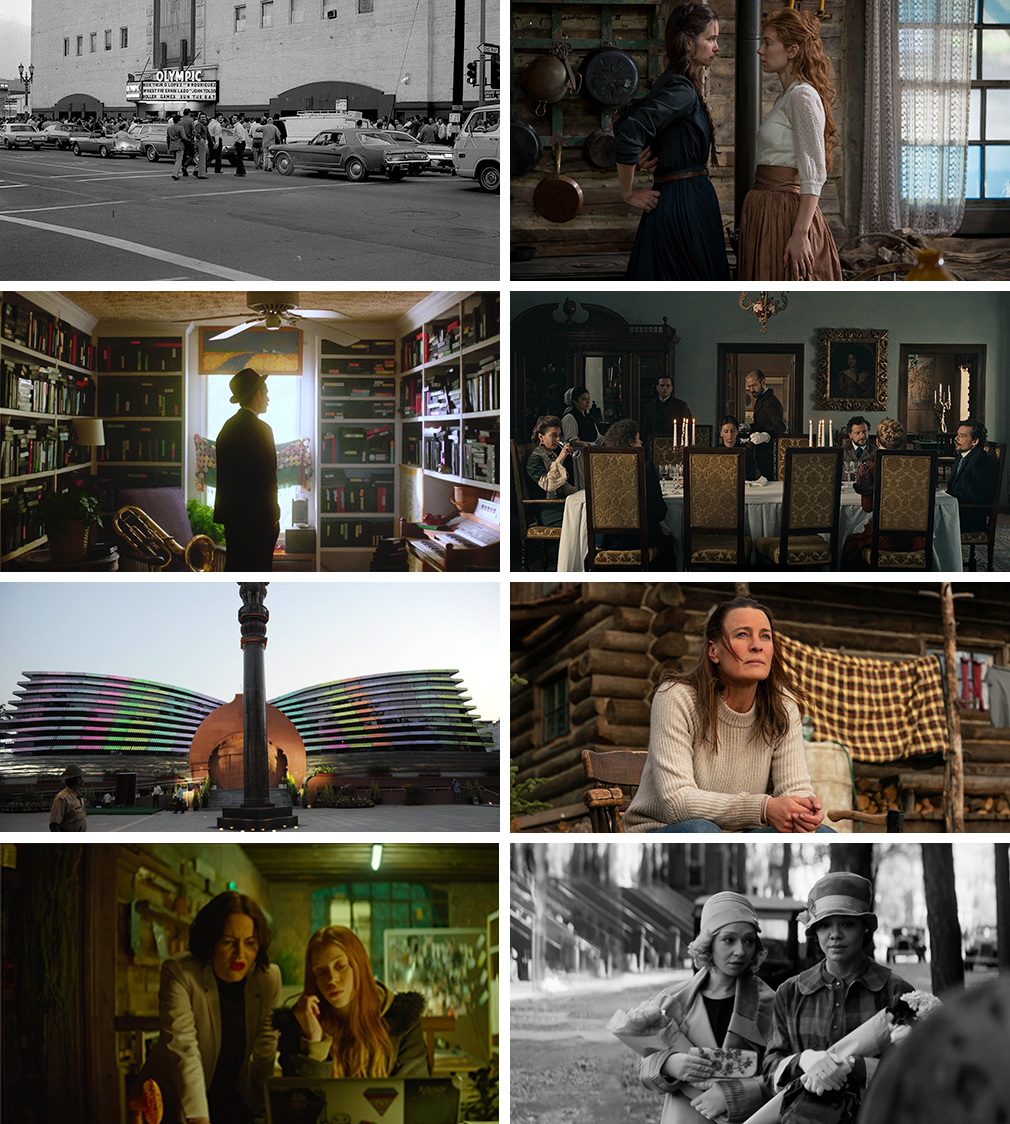
CLOCK WISE FROM TOP LEFT: 18th & Grand: The Olympic Auditorium Story, The World to Come, Malmkrog, Land, Passing, A Brixton Tale, Letter from Your Far-Off Country, Strawberry Mansion.
Scene Setters
This is a quick rundown of films that are characterized by their settings or locations. Aqui y Allá (NYFF) literally tracks through digital interfaces, maps, aerials photos, archival materials, and images, where the filmmaker’s family has lived across the world after 20th century upheavals. Notes, Imprints (On Love): Part 1 (NYFF) are the traces of locations of personal importance — a largely empty shopping center, industrial buildings, streets, houses, a diner, a spare wood house. The fanciful Pepto Bismol-colored Strawberry Mansion (Sundance) is where an assessor comes to do an audit on dreams which are taxed. Log cabins feature both historically in The World to Come (Sundance) and today in Land (Sundance). Upper East Side New York and Paris set the scene for French Exit (NYFF), while London is the indelible backdrop for Lovers Rock (NYFF) and A Brixton Tale (Slamdance). City Hall (NYFF) portrays the inner workings of Boston, while 18th & Grand: The Olympic Auditorium Story (Slamdance) showcases the growing pains of Los Angeles. Passing (Sundance) is set in 1920s Harlem while Malmkrog (NYFF) takes place on an estate in pre-WWI Transylvania. The Lobby (NYFF) showcases these semi-public spaces, the transition between outside and inside in apartment buildings in Buenos Aires, Argentina. We are transported to Asian built environments in The Disciple (NYFF) set in locations throughout India where music is played; Letter from Your Far-Off Country (NYFF & Slamdance) features the National Memorial Museum in New Delhi a new building in the shape of an open book — literally — designed by architect Ajay Behl; The Woman Who Ran (NYFF) crosses Korea; The Calming (NYFF) travels to domestic spaces in China and Hong Kong; See You in My Dreams (NYFF) in Japan; and The Unseen River (NYFF) in Viet Nam. While Cursed by Spectres (NYFF) displays German locations that stand in for the imagined country of Kafka’s unfinished novel America, Her Name Was Europa (NYFF) takes place at the largest column-free building in the world, originally the Brand-Brisen Airfield hangar that is now an indoor water park called Tropical Islands.
All Films Mentioned
SUNDANCE
A Glitch in the Matrix, directed by Rodney Ascher
Bring Your Own Brigade, directed by Lucy Walker
El Planeta, directed by Amalia Ulman
Human Factors, directed by Ronny Trocker
Kkum, directed by Yihan Lin
Land, directed by Robin Wright
Lata, directed by Alisha Tejpal
Passing, directed by Rebecca Hall
Strawberry Mansion, directed by Albert Birney, Kentucker Audley
Street Gang: How We Got to Sesame Street, directed by Marilyn Agrelo
Taming the Garden, directed by Salomé Jashi
The Fire Next Time, directed by Renaldho Pelle
The Pink Cloud, directed by Iuli Gerbase
The World to Come, directed by Mona Fastvold
Trepanation, directed by Nick Flaherty
SLAMDANCE
18th & Grand: The Olympic Auditorium Story, directed by Stephen DeBro
A Brixton Tale, directed by Darragh Carey and Bertrand Desrochers
About a Home, directed by Daniel Chein and Elizabeth Lo
Holy Frit, directed by Justin Monroe (winner Audience Award Documentary Feature )
Inside and Outside the Wall, directed by Yihan Lin
Opera, directed by Erick Oh, (Academy Award nomination, Animated Short Film)
Return to the Peach Blossom Wonderland, directed by Haomin Peng, Yue Huang, and Yuchao Luo
Taipei Suicide Story, directed by KEFF (winner Grand Jury, Audience Award for Narrative Features and the Best Actor)
The Long Fall, directed by Cade Mirabitur
Vision of Wonder, directed by Aleksander Johan Andreassen
NEW YORK FILM FESTIVAL
A Revolt Without Images, directed by Pilar Monsell
Aqui y Allá, directed by Melisa Liebenthal
City Hall, directed by Frederick Wiseman
French Exit, directed by Azazel Jacobs
Her Name Was Europa, directed by Anja Dornieden, Juan David González Monroy
Letter from Your Far-Off Country, directed by Suneil Sanzgiri
Lovers Rock, directed by Steve McQueen
Malmkrog, directed by Cristi Puiu
Notes, Imprints (On Love): Part 1, directed by Alexandra Cuesta
Object Lessons, Or What Happened Whitsunday, directed by Ricky D’Ambrose
See You in My Dreams, directed by Shun Ikezoe
The Calming, directed by Song Fang
The Disciple, directed by Chaitanya Tamhane
The Human Voice Delimitation, directed by Pedro Almodovar
The Isolated, directed by Jay Giampietro
The Lobby, directed by Heinz Emigholz
The Unseen River, directed by Phạm Ngá»c Lân
The Woman Who Ran, directed by Hong Sangsoo
While Cursed by Spectres, directed by Burak Çevik
Observed
View all
Observed
By Susan Morris
Related Posts

Business
Courtney L. McCluney, PhD|Essays
Rest as reparations: reimagining how we invest in Black women entrepreneurs

Design Impact
Seher Anand|Essays
Food branding without borders: chai, culture, and the politics of packaging

Graphic Design
Sarah Gephart|Essays
A new alphabet for a shared lived experience

Arts + Culture
Nila Rezaei|Essays
“Dear mother, I made us a seat”: a Mother’s Day tribute to the women of Iran
Recent Posts
Candace Parker & Michael C. Bush on Purpose, Leadership and Meeting the MomentCourtney L. McCluney, PhD|Essays
Rest as reparations: reimagining how we invest in Black women entrepreneurs Food branding without borders: chai, culture, and the politics of packaging Why scaling back on equity is more than risky — it’s economically irresponsibleRelated Posts

Business
Courtney L. McCluney, PhD|Essays
Rest as reparations: reimagining how we invest in Black women entrepreneurs

Design Impact
Seher Anand|Essays
Food branding without borders: chai, culture, and the politics of packaging

Graphic Design
Sarah Gephart|Essays
A new alphabet for a shared lived experience

Arts + Culture
Nila Rezaei|Essays

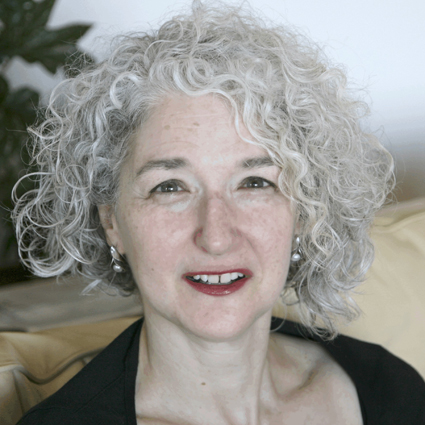 Susan Morris works across media — film, television, radio, exhibitions, public programs, print, digital media — specializing in the arts and culture with an emphasis on architecture & design as a producer, director, editor, curator and writer. She has worked at Publications: Louise Blouin Media (Editor-in-Chief, Modern Painters), Architect’s Newspaper, Art Newspaper, Artbyte, Documentary, Dwell, Eye, House & Garden, and Design Observer; Foundations: Ford Foundation, NEA, Rockefeller Foundation; Media Production: WNYC/PRI (founding Executive Producer Studio 360), BBC UK, Bravo, IFC, NY Times Television, WNET/Thirteen; Museums & Institutions: Cooper-Hewitt National Design Museum, J. Paul Getty Trust, International House, Metropolitan Museum of Art, MoMA.
Susan Morris works across media — film, television, radio, exhibitions, public programs, print, digital media — specializing in the arts and culture with an emphasis on architecture & design as a producer, director, editor, curator and writer. She has worked at Publications: Louise Blouin Media (Editor-in-Chief, Modern Painters), Architect’s Newspaper, Art Newspaper, Artbyte, Documentary, Dwell, Eye, House & Garden, and Design Observer; Foundations: Ford Foundation, NEA, Rockefeller Foundation; Media Production: WNYC/PRI (founding Executive Producer Studio 360), BBC UK, Bravo, IFC, NY Times Television, WNET/Thirteen; Museums & Institutions: Cooper-Hewitt National Design Museum, J. Paul Getty Trust, International House, Metropolitan Museum of Art, MoMA.